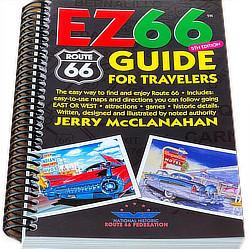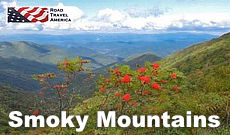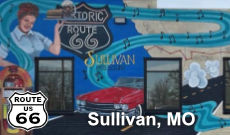
Road Trip Planner for Historic U.S. Route 66 in Carthage
 |
"The Mother Road" was established on November 11, 1926, and ultimately stretched 2,448 miles from Chicago to Los Angeles. Starting in Chicago, westbound travelers traversed a series of towns in Illinois before arriving in St. Louis.
Heading westbound in Missouri, the route traveled through these cites and towns:
Historic U.S. Route 66 Byway in Missouri |
Route 66 across Missouri stretched 317 miles and connected a variety of large cities and small towns, traversing rolling hills and valleys. The Mother Road followed much of the Kickapoo, or Osage, Trail, an Indian trail that later became the Old Wire Road. Like other Route 66 segments, the actual alignment varied over the years as engineering improvements were constructed. We've driven much of Route 66, including multiple segments across Missouri, and visits to Carthage. |
Carthage Missouri ... Background
A popular stop on Route 66 today is the town of Carthage, situated between Springfield and Joplin. It features numerous Route 66 attractions and other things to do, and offers a variety of overnight lodging options for travelers.
 Jasper County Courthouse in Carthage |
It was founded in 1841, and is county seat of Jasper County.
U.S. Highways 66 and 71 came through Carthage in the 1920s, and the town experienced a stream of cross-country traffic. One of the first concrete-paved portions of Missouri's highway system was the stretch of road west of Carthage to Joplin laid in 1920.
Route 66 intersected with U.S. Route 71 at the present intersection of Central and Garrison Avenue. Route 66 was eventually re-routed, and replaced in the 1960s with Interstate 44 south of town.
Carthage Missouri Today
Today Carthage is an energetic, thriving town of over 14,000 residents. In addition to Route 66 attractions such as the 66 Drive-in Theatre, a number of other places are popular with residents and visitors, including these:
- Jasper County Courthouse, one of the most photographed buildings in Missouri, and listed on the National Register of Historic Places.
- Red Oak II
- Historic Carthage Square
- Powers Museum
- Boots Motel
- Carthage Municipal Park
- Stones Throw Theatre
Map showing the approximate location of Carthage on Historic Route 66 in Missouri

Scenes Around CarthageOne of the first concrete-paved portions of Missouri’s highway system was the stretch of road west of Carthage to Joplin, laid in 1920. In 1926, this route became part of Route 66. Along the route today travelers find Kellogg Lake, Powers Museum, Carthage Municipal Park, Stone’s Throw Dinner Theatre, 66 Drive-In Theatre and the 1939 Boots Court. |
Boots CourtThe Boots Court, a historic motel, is located along the famed U.S. Route 66 in Carthage, Missouri. One of the oldest and few remaining in operation on Route 66, The Boots was constructed in 1939 by Arthur Boots. After many decades of catering to travelers, this iconic and unique Streamline Moderne motel fell into disrepair. Over the last decade, flat roof restoration was completed and partial room renovations were begun by previous owners. The nonprofit Boots Court Foundation saved the motel from possible demolition and has overseen a full restoration. Boots Court is now open for Route 66 travelers to enjoy, at 107 South Garrison Avenue in Carthage. Official website of the Boots Court and Boots Court on Facebook ... Phone 417.310.2989 Traveler reviews and photos of the Boots Court at TripAdvisor |
|
 |
 |
| The Boots Court Motel Visitors Center was completed in the fall of 2023, next door to the motel. It serves as the motel office and a visitors center for travelers. It’s an old Sinclair gas station and is looking great after extensive work and restoration! The owners stock lots of special "Carthage Only" products for both tourists and locals to purchase. | |
 |
|
More Lodging Options in Carthage
|
Carthage, Missouri hotels, traveler reviews and reservations Carthage Travel Guide |
Please come again! To Carthage Missouri on Route 66! |
EZ66 Guide for Travelers (5th Edition) by Route 66 Authority Jerry McClanahan  |
66 Drive-In TheatreIt is located at 17231 Old 66 Boulevard in Carthage. Phone 417.359.5959 For more information, opening dates and show times, visit the official website of the 66 Drive-In Theatre |
|
 |
 |
Red Oak IITwo miles northeast of Carthage, and just off of Route 66, is the community of Red Oak II, created by artist Lowell Davis. After he discovered that his hometown of Red Oak had become a ghost town, he bought buildings from there and moved them to his family's land near Carthage, and gave them new life. He called this creation Red Oak II. Visitors today will find a collection of early 20th century buildings like a general store, a Phillips 66 station, an old school house and a church. Today, each of the buildings in Red Oak II are privately owned. Admission is free. Many roadtrippers on Route 66 traveling in western Missouri make a visit to Red Oak II. Structures such as the Phillips 66 gas station bring back memories of those earlier years on the Mother Road! Route 66 travelers from around the world make Red Oak II a "must see" attraction. It is physically located at 12275 Kafir Road, Carthage, MO 64836 For more information, visit the official website of Red Oak II and phone 417.237.0808 View traveler comments/reviews and more photos at Red Oak II at TripAdvisor |
|
 |
 |
Gay Parita Sinclair Filling StationThe original structure on this site near Carthage was built in 1930 by Fred and Gay Mason. Fred named the station "Gay Parita" after his wife Gay. The station burned in 1955 and did not reopen. It was later lovingly recreated by Gary and Lena Turner in 2005. Gary passed away in 2015, and the site is commonly known today as "Gary's Gay Parita". Barbara Barnes, Gary's daughter, and George Bowick continue to operate the station today. It is located between Halltown and Spencer, Missouri, about 25 miles west of Springfield, 3 miles west of Halltown and close to Carthage. Route 66 roadtrippers always make a stop at this station, at 21118 Old Highway 66, Ash Grove, Missouri (see map below). Highly recommended! For more information, visit Gary's Gay Parita website and Gay Parita on Facebook or phone 843.324.6661
|
Route 66 Crossroads Festival A popular stop on Route 66 today is the town of Carthage, situated between Springfield and Joplin. It features numerous Route 66 attractions and other things to do, and offers a variety of overnight lodging options for travelers. Today Carthage is an energetic, thriving town of over 14,000 residents. In addition to Route 66 attractions such as the 66 Drive-in Theatre and the Boots Court. The annual Crossroads Festival celebrates the junction of Route 66 and the Jefferson Highway in Carthage. More Info: Website |
Interactive Map of Carthage, Missouri
More Information & Resources about Carthage |
|
Best-Selling Route 66 Books and Maps at our Amazon Store |
|
| Route 66 Travel Guide - 202 Amazing Places by Mark Watson  |
Route 66 Full-throttle Adventure Handbook, by Drew Knowles  |
| EZ66 Guide for Travelers (5th Edition) by Jerry McClanahan  |
Rand McNally 2026 Road Atlas Large Scale Spiral Bound  |
About These ProductsThe Route 66 Road Trip website is a participant in the Amazon Services LLC Associates Program, an affiliate advertising program designed to provide a means for sites to earn fees by advertising and linking to Amazon.com and affiliated sites. Amazon offers a commission on products sold through their affiliate links. There is no additional cost to you. |
|
Earlier Times: Vintage Views along Route 66 in Carthage
We have included below a sampling of our collection of vintage travel postcards dealing with Carthage and Route 66. What was Route 66 like in its earlier years, as visitors drove around and through Carthage? What did all the service stations, motels and public buildings look like when they were new? What did the traveling public experience on the Mother Road? We wonder such things when we travel Route 66 today. Those earlier times in the 1930s, 40s and 50s were not always captured on film. But the use of colorful postcards was common in those decades. These portray the historic road in its prime and help us to visualize, and appreciate, "earlier times" as we drive Route 66 today around Carthage. |
||||||
|
|
||||||||||||
Other Popular Road Trips on Our Other Website |
||
 |
 |
 |



















